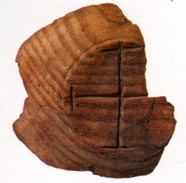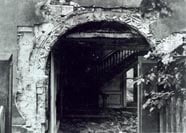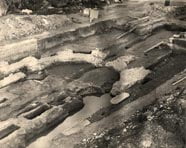The Priory

A wooden bowl found close to the monastic fishponds
The manor of Merton, which belonged to the Crown, was given by Henry I to Gilbert the Norman, Sheriff of Surrey. In 1114 Gilbert established a priory of austin canons at Merton under Robert, sub-prior of St Mary’s Huntingdon. This first church was of timber and was probably located in the western part of the manor, near to the site of the present parish church. Land was added which brought in an annual return of 60 shillings. Among its distinguished visitors was Queen Matilda, who had great affection for the place and brought her son William to see it.

A 12th century arch found during the demolition of “Abbey House” in 1914
On 3 May, 1117 the canons moved to a new site ‘more suited to the quiet of religion and in many respects more convenient’, which their founder secured for them. This new site was at the present location of the Priory, within an area covering sixty acres on the banks of the Wandle. In a Latin text concerning Gilbert, the founding of the new priory is clearly mentioned:
‘In time Robert saw the advantages of another site, but (was) timid about approaching Gilbert on this matter. But finally (he) discussed it directly, and both of them (were) soon seen, on foot or horseback, marking out space for the church, the circuit of the cemetery, deciding how water was to be drawn from its main body, and where the mill and vineyards were to be. Buildings were transported from the earlier settlement. A wooden chapel was constructed, and William Gifford, bishop of Winchester arrived to bless the cemetery’.

The chapter house
The canons (now 17 in number) ‘marched festively’ into their new community. Gilbert brought bishops and nobles to see it and to instill affection for it. He sent grain, wine, meat, fish and cheeses and bought cloth for the brethren, whom he was often kissing and talking to’.
In 1121 Gilbert was granted the entire manor of Merton in consideration of one hundred pounds of silver and six marks of gold. In the year of his death, 1125, Gilbert began a most beautiful and sturdy church at Merton but because it ‘seemed too great for certain persons’ it was destroyed after his death, except for the front, where ‘the sheriff had laid the first stone and the prior had set the second’. This building work appears to have continued, for in 1131 ‘Archbishop Corbeil was actively engaged in reconstructing the priory in stone’. This work seems to have been completed in 1136. Other building work continued on the site for at least another forty years, for in 1161 the Chapel of the infirmary was dedicated and around 1175 an ‘Important building was completed’. Around 1128 Thomas Becket, later Archbishop of Canterbury was educated at Merton Priory.

The infirmary hall and reredorter
During the early part of the 13th century Merton priory, like many other monasteries throughout Britain, saw a period of great expansion. At Merton this programme of rebuilding and expansion probably followed the general trend but was also instigated by repairs to the 12th century church. The Dunstaple Annals record that in December 1222 a storm, which also damaged that priory, blew down the tower of Merton and many other buildings throughout England and it was very probably this incident which led to lengthy programme of rebuilding at the priory which was still in progress in the 1260s. During the 1220s Walter (later known as Walter de Merton) was sent to be educated at Merton priory. His education was completed by 1231.
In 1232 Hubert de Burgh, chief justiciar, fled to the priory for sanctuary and was pursued there by the king who demanded that he yield himself and face due process of law. On his refusal King Henry ordered the mayor of London to summon all citizens capable of bearing arms and capture Hubert dead or alive. An armed mob of some 20,000 quickly assembled and marched on Merton where Hubert took up a strategic position before the high altar and awaited developments. In the end the City contingent was dismissed, and Hubert was induced to leave the priory under what he was led to believe was a safe-conduct, arrested and duly brought to the Tower. Years later this event was known as Hubert’s siege at Merton.
On 17 July 1235 Merton was made the collection point for the royal aid levied in Surrey and as in most of these conventions and occasions the priory no doubt proved a particularly convenient location on account of its closeness to London on one of the main routes through the county, and probably even more by the size of its accommodation.
In January 1236 there was a meeting of the council of barons which assented to the famous set of statutes, concerning among other matters women’s dower and wills, that took its name from the place. Other assemblies convened at Merton in this period were a royal council of January 1255 and a convocation of the church on 6 June 1258, summoned there by Archbishop Boniface.
During the middle of the 13th century further building work on the church is indicated for on 5 February 1253 Edward of Westminster was ordered to ensure that the silver image of Blessed Mary which had begun to be made for the use of the prior and convent of Merton should be completed and delivered to them. Presumably the image was intended to adorn the conventual church, and it is notable that the following year Peter Chasepore, the Queen’s treasurer, bequeathed to Merton 60m to buy land for the support of a chantry at the priory church.
For the first three quarters of the century at least, during the reign of Henry III, relations between Merton and the Crown were relatively relaxed and cordial. Since Queen Matilda, who had given the priory so much moral and material support at the time of its foundation, King Henry was much the fervent royal patron of religious orders, and he enjoyed a particularly close personal relationship with Merton.
Between 1217 and his death in 1272 he stayed at Merton some 54 times, sometimes for a couple of days only but more often for one or two weeks. Most of these visits took place at the start or end of a royal progress, so that Merton, at a distance of only seven miles from London, evidently made a convenient royal staging-post, at least on more leisurely journeys. Much the most usual stopping place next to the west was Guildford, 16 miles away, and another frequent one was Kingston, only five miles away.
On 13 October 1344 Merton was selected to provide a suitable and strong house with free access for the use of the collectors for the Surrey of the tenth and fifteenth granted by Parliament. This was probably a repeat of the arrangements in 1235, when the priory was the collection point for the royal aid. On 8 April 1347 the prior of Merton was ‘invited’ to contribute an aid for the war with France which had just broken out. At the end of the century, on 17 October 1397, the king acknowledged his obligation to repay to the prior of Merton, among many other such creditors, a loan of £40.
Between 1346–49 royal sports were held at Merton Priory on the feast of Epiphany, presumably for the amusement of Edward III. The accounts of Great Wardrobe of King Edward III show there were supplied thirteen visers (masks) with heads of dragons, and thirteen with heads of men and ten courtepies (short cloaks) of black bokeram and twelve yards of English canvas of flax.
Documentary sources relating to the conventual church during this period are from the latter part of the 14th century. On 9 June 1382 Bishop Wykeham permitted the prior and convent to have three altars consecrated or dedicated within their church by Bishop William of Nantes, together with two portative altars or altar tops.
It would appear that the church was in a state of disrepair by the end of the 14th century. Between April 14th and 23rd in 1393 the Prior sent a certificate to the Bishop concerning the status of the house. This included a reference stating that the Chapel of the Blessed Mary existed in ‘a truly decayed and ruinous state which according to the opinion of the masons and carpenters would require 240 marks to repair’. Also that ‘the nave of the church existed in a similar state of disrepair and would require 2000 marks for repairs’. This request was presumably met as various repair programs were instigated at the close of the 14th century.
Henry VI crowned at Merton
Henry VI [Born 6 December 1421, King 1422-61, 1470-71] had been crowned King of England at Westminster in 1429, and King of France in 1431. On 1 November 1437 aged 15 he performed a crown wearing ceremony at Merton, recorded in the Acts of the Privy Council as follows:
“Deliv’ed by youre saide Comaundem’t. the Erles of Warrewyke and Stafford and youre Chamb’leyn beying p’sent at that same tyme, that is to say, on Alle halowensday laste,.at Merton, whaune ye wer crouned, ye yaf to an heraude Kynge of armes (afore that tyme called Angoye, and thanne, at that fest, his name changed by you, and called Lancastre), j belle of sylver weying xvj m’re, and an other belle of sylver at that tyme deliv’ed to oon that was made pursevant, and than called Coler, the which wyed viil m’re’.”
[From: Heale The Records of Merton Priory 1899 p. 299]
The archaeological excavations

Recording a tile floor within the main church
The earliest excavation were carried out in between 1921 and 1922 by Colonel H.F. Bidder, a local antiquarian. Bidder’s excavations revealed the exact location and basic ground plan of the church and chapter house and also revealed some of the internal flooring within both of these buildings. In 1962 and 1963 Dennis Turner undertook an excavation located to the west of the church which uncovered a 14th century flint cobble trackway.
Full excavation of the chapter house took place between 1976-1978 and 1983 which revealed the ground plan of the chapter house, a small section of the cloister walk and part of the infirmary complex.
The most extensive phase of excavations on the site of Merton Priory was between 1986 and 1990 by the Museum of London. These excavations concentrated on the church, the lay cemetery to the north of the church, part of the cloister range, the canons’ cemetery and the infirmary range. Recent excavations by the Museum of London Archaeology Service in 2002 and 2003 have revealed the monastic mill, medieval fishponds, a medieval road and further monastic building.
The largest and most important building within the monastic complex was the church, which normally stood on the north side of the cloister. This is the position of the priory church at Merton. The church is shaped like a crucifix, the arms of the cross being formed by the transepts to the north and south of the aisle. The east end or chancel was shorter than the west end or nave.
The first phase of a stone church excavated on the site was commenced in c1170 and was probably completed at the end of the 1190s. Worked stone from the site suggests this was not the first stone church on the site and it is probable that an earlier mid 12th century church existed somewhere on the site. The church was rebuilt in the early 13th century probably in response to damage instigated by the documented fall of the tower in 1222 recorded in the Annals of Dunstable. In the 13th century, it appears that, as a single phase, the following buildings were constructed to the south of the new church; a square-ended chapter house, separated from the south transept by a passage or room, possibly a slype or vestarium; parts of the cloister walk and ranges; an undercroft, the infirmary, with its own cloister. To the north and south of the church were found extensive cemeteries. Later additions of a new chancel and Lady chapel resulted in a church that measured 110m long at its greatest extent in the 14th century, placing it firmly amongst the largest churches in the Greater London region.
A total of 738 medieval inhumations were excavated. These individuals were buried in a number of ways such as interred in simple shrouds, coffin burials (both lead, stone and wood), cists of various forms, interments placed on ‘grave pillows’ and a burial on ash or charcoal.
Merton had a large infirmary hall. Adjoining the infirmary hall was the infirmary kitchen which was attached to the eastern wall of the hall. The infirmary hall dates to the first half of the 13th century. Window glass recovered from the 14th century rebuilding deposits (during the repair and partitioning of the infirmary hall) suggests the infirmary windows were highly decorated with blue and green stained glass windows, many fragments of which were painted with foliate motifs and one fragment painted with wings.
The excavation also produced evidence of medical practices. Evidence of medical care can also be found from one of the skeletons buried within the north transept. This skeleton has been identified as an adult male of between age 26 to 45 at death and was found clutching a hernia belt placed low down on the pelvis. Another burial, a male aged 26-45 at death, was interred with a metal object on the knee area. This copper alloy object, a ‘medication sheet’ is thought to have been therapeutic in their application, possibly for arthritic or other conditions.
Recovered from the many soil samples collected from the excavation was the presence of medicinal herbs and spices. An exceptionally large number of black mustard seeds were found within a river deposit which represents the contents of a bag imported into the priory. Relatively large numbers were recovered from a floor deposit within the infirmary kitchen. These seeds may have either been used for food and/or for medicinal purposes.
A number of the other plants represented in the samples may have been exploited for their medicinal properties, possibly for use in the infirmary. For example, opium poppy, henbane, black nightshade and hemlock were found.
The evidence for food and diet derives mainly from the area of the infirmary kitchen, (where cooking was carried-out on a pitch-tile hearth located within the eastern part of the kitchen), the infirmary cloister and a number of ditches, possible bedding pits. In one ditch were a number of “hatched” chicken and goose eggs. Other ditches produced seeds of fruits such as grape, apple, plum/bullace, sloe/blackthorn, blackberry/raspberry, elder, hazel and walnut. A number of cereals were also found including wheats and barley. Smaller numbers of rye and oat grains were also found. The bones of animals were also found within the infirmary complex. These included cattle, sheep/goat and pig, chicken, goose and mallard/domestic duck. Bones of varied range of game species included blackbird, dove/pigeon, wood pigeon, common/grey partridge, woodcock, heron, wild duck and swan and bones of mammals included red deer, fallow deer, roe deer, brown hare, and rabbit. The fish diet shows included both marine, estuarine and fresh water species including herring, cod, whiting, haddock, smelt, eel, thornback ray, sturgeon, plaice/flounder, conger eel, gurnard, mackerel, pike, carp and common bream.
By David Saxby of Museum of London Archaeology